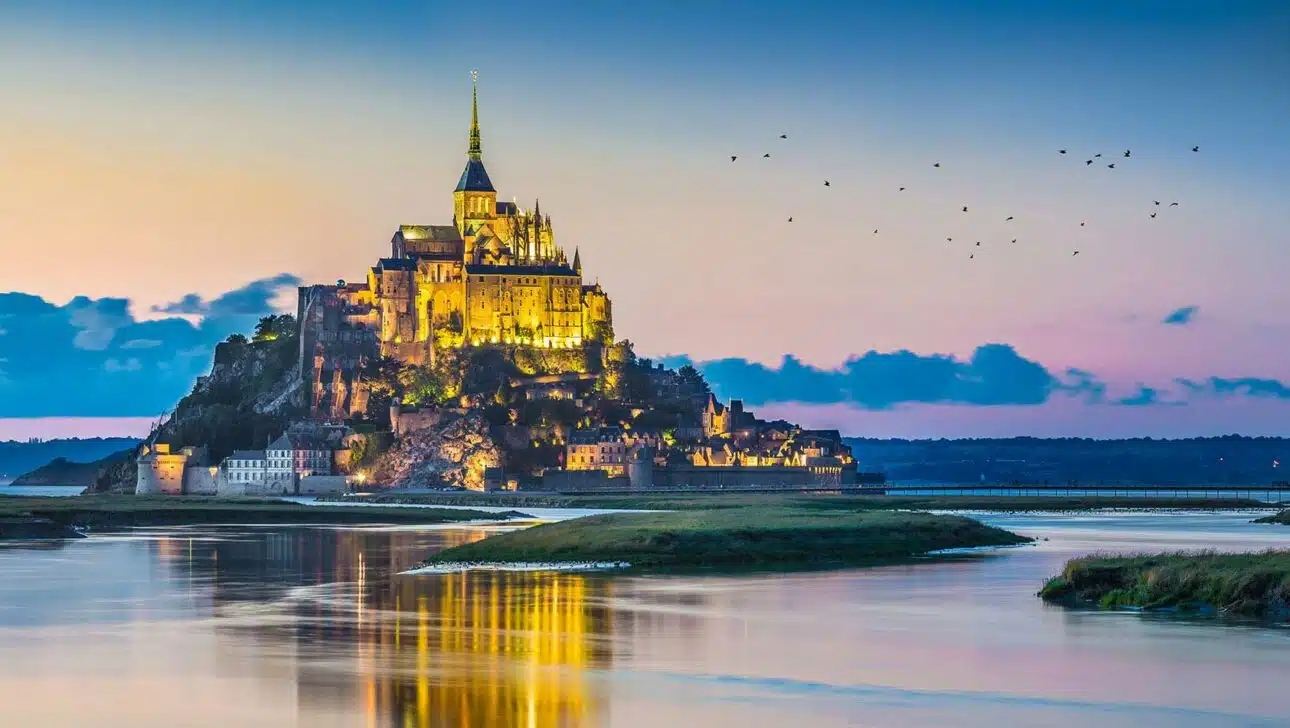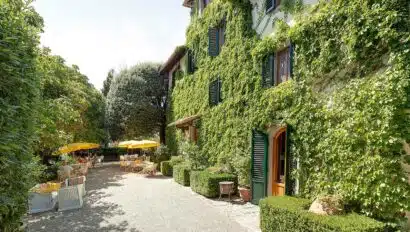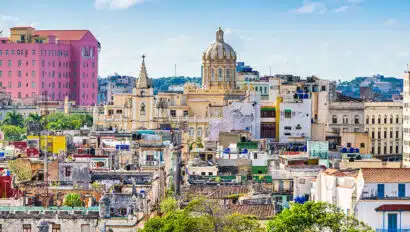I’d never taken a 5-mile barefoot walk until a couple of weeks ago. Suburban tenderfoot that I am, there aren’t many places where that’s possible (or bearable). Then I went to Mont St.-Michel. Even if you don’t recognize the name, you’ll probably recognize the place. It’s the iconic French abbey that makes you think of a medieval rocket launch, the way its stratospheric stone spire surges up from a cloud of stone. The island is in Normandy, just at the border with Brittany. As a UNESCO World Heritage Site, it’s one of France’s most popular sites.
The legend says that Archangel Michael appeared to Bishop Aubert and commanded him to erect a church on what was then a bare, rocky island. Aubert didn’t think it was doable (and it’s easy to see why). He didn’t go for it until the irked Archangel burned a hole in his skull with a touch of his finger. Message received. Today, the stairs to the top are well worth the chance to see how this massive structure floats above the world. For me, though, the best part was the views out over the bay that surrounds the island. It’s down there that one of my best walks ever happened.
Here’s how it works. The bay has some of the world’s biggest tides. At some points, there’s almost a 50-foot difference between the very highest and lowest tides. At low tide, the water’s edge recedes by nine miles or so from the coast. For centuries, that was how access to Mt. St.-Michel was controlled. Pilgrims made the trip when the bed of the bay was revealed. The trick was to be anywhere but out there when the water swept back in. There’s a causeway now, so 99% of visitors keep their feet completely dry. The travelers in our group were part of the other 1%, and this is a minority I definitely wanted to be a part of.
Alexandre made all the difference. He’s the trained, licensed guide who was engaged to lead us. Rucksacked and GPS’d, he knows the bay inside out. He’s the guy whose brain is programmed to remember how many hours it is until the tide flows back. (Whew.) He knows what kind of jiggly surface signifies quicksand. (Double whew.) Best of all, he’s just a cool guy. And his first suggestion, while we’re still on dry land, is to lose the TEVA’s and water shoes we thought we should wear. “Barefoot is better,” he said. I tucked mine into my daypack – just in case. But he was right.
The floor of this bay is like no place I’ve ever walked. It’s covered with various mixtures of silt and sand. At its softest, your feet may sink in 2 inches or so, but that’s only for limited stretches. Otherwise, the surface is firm, rippled sand. For the first mile or so of our low-tide walk it was like playing in the biggest water puddle of all time. The water was just an inch or two deep and utterly clear. Great splashing. Those epic tides constantly flush the bay. So there are no stones underfoot, only occasionally a small scallop shell and once in a great while a jellyfish that didn’t swim fast enough to keep up with the receding water. Easily seen, easily avoided.
Alexandre stops a couple of hundred yards from the island. He loves this view because it’s the one the tourists don’t see. From the bay side, Mt. St.-Michel shows its more natural face. The rocky base is covered with trees, rather than the houses and shops you see from the mainland side. You can imagine how this place looked 800 years ago when it must have been mind-boggling beyond imagining. From out here, the mind still boggles. The people you know to be inside those walls are utterly invisible. It’s just the sands and that view.
In other places we visited on our tour of Normandy along the French coast, such as the adjacent Bay of Cancale, the locals take advantage of the low tides to drive tractors out onto the flats to tend their oyster farms. That doesn’t happen here, though. Your feet are wet, but you’re tempted to think of this as a desert. It’s wide, flat, sandy…and when the sun shines, you’re glad for a hat, some sunglasses and a smear of sunscreen.
Of course, deserts don’t have watery channels running through them, like the one or two we encountered on this walk. There’s a shimmer of water where you’re standing now. A hundred feet away it’s completely dry. But in between, not so much. Alexandre asked us to stand by as he made his way across, checking the depth (about 2- 2.5 feet) and the firmness (no quicksand). This is why you obey the suggestion to wear shorts. Sure your hems will get wet, but so what? The water is absolutely clear so you can always see the bottom, and this is just the photo op you want: You, thigh-deep with the abbey floating in the background and not another human being anywhere in sight.
In the parts of the bay that are closer to shore, more life emerges. These are the areas that are covered by water less often and only by the very highest tides. There’s a small succulent plant that starts to appear. Alexandre plucks a few branches for us to taste. No surprise, it’s salty, but the locals use it on salads and in other ways. Where water coverage is even less common, there’s salt grass – the forage preferred by the local sheep whose meat has a distinctive flavor due to this unique diet.
Too soon for me, this walk is over. Out come the socks and the walking shoes. It’ll take a day or two for the silt under our toenails to finally wash away. But I have to say that this is one of those walks that will stick with me forever. For us travelers who keep score, it’s a big win. Yes, I’ll meet people who’ve been to Mt. St.-Michel, and I’m betting 9.5 times out of 10, I’ll be able to top them with my stories of the walk they didn’t even think of taking. We got a historical, cultural and ecological perspective on this beautiful place. I’m telling every traveler I know: If you get to Mt. St.-Michel, lose the shoes and walk the walk. You will not regret it!
__________________________________________________________________________________________
Steve Snapp is Co-founder and Creative Director of Classic Journeys. The visit to Mt. St.-Michel is just one stop on the 7-day, 6-night cultural walking tour of Normandy & Brittany . Other highlights include visits to the D-Day Beaches, the Bayeux tapestry, a family oyster farm, the orchards where Calvados is made, and St. Malo. For more information or a detailed daily itinerary on our tour of Normandy and Brittany, you can call Classic Journeys at 1-800-200-3887.




